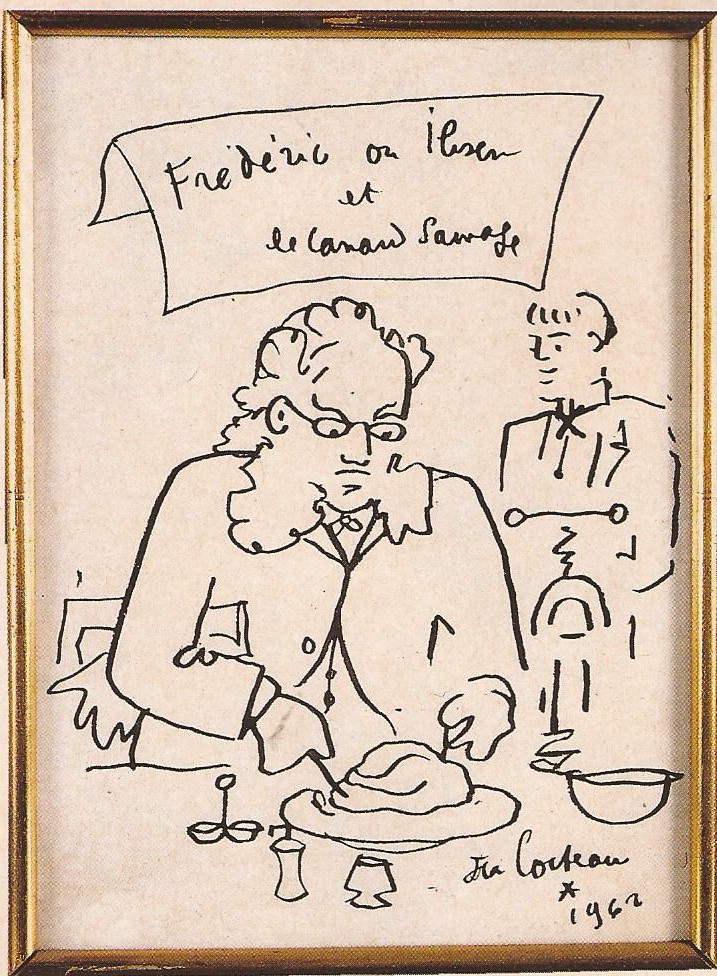 The first Donald Duck model sheet. Created in 1934 for the Disney cartoon The Wise Little Hen
The first Donald Duck model sheet. Created in 1934 for the Disney cartoon The Wise Little Hen
 Still from The Wise Little Hen (Wilfred Jackson, 1934)
Still from The Wise Little Hen (Wilfred Jackson, 1934)
 Poster by Tom Whalen
Poster by Tom Whalen
 It was his second appearance in Orphan’s Benefit (Burt Gillett, 1934) that introduced Donald as a temperamental comic foil to Mickey Mouse.
It was his second appearance in Orphan’s Benefit (Burt Gillett, 1934) that introduced Donald as a temperamental comic foil to Mickey Mouse.
 Carl Barks, best known for his comics about Donald Duck and as the creator of Scrooge McDuck. Fans dubbed him “The Duck Man” and “The Good Duck Artist”.
Carl Barks, best known for his comics about Donald Duck and as the creator of Scrooge McDuck. Fans dubbed him “The Duck Man” and “The Good Duck Artist”.
 Drawing by Don Rosa
Drawing by Don Rosa
The Duck universe also called the Donald Duck universe, Duckburg or Scrooge McDuck universe) is a fictional universe where Disney cartoon characters Donald Duck and Scrooge McDuck live. It is a spin off of the older Mickey Mouse universe, yet has become much more extensive. “Duck universe” is a term used by fans and is not an official part of the Disney lexicon.
 The New Spirit (Donald Duck), Andy Warhol, 1985
The New Spirit (Donald Duck), Andy Warhol, 1985
 Look Mickey, Roy Lichtenstein, 1961
Look Mickey, Roy Lichtenstein, 1961
 Daffy Duck first appeared in Porky’s Duck Hunt (Tex Avery, 1937)
Daffy Duck first appeared in Porky’s Duck Hunt (Tex Avery, 1937)
 The only aspects of Daffy Duck that have remained consistent through the years are his voice characterization by Mel Blanc and his black feathers with a white neck ring.
The only aspects of Daffy Duck that have remained consistent through the years are his voice characterization by Mel Blanc and his black feathers with a white neck ring.
 Howard the Duck is a comic book character in the Marvel Comics universe created by writer Steve Gerber and artist Val Mayerik. The character first appeared in Adventure into Fear #19 (Dec. 1973)
Howard the Duck is a comic book character in the Marvel Comics universe created by writer Steve Gerber and artist Val Mayerik. The character first appeared in Adventure into Fear #19 (Dec. 1973)
 Paul and Linda McCartney with their daughters Heather, Stella and Mary. April 1976
Paul and Linda McCartney with their daughters Heather, Stella and Mary. April 1976
 Elton John. Central Park Concert, 1980
Elton John. Central Park Concert, 1980
 Photo by Irving Penn
Photo by Irving Penn
 Self portrait, Duane Michals
Self portrait, Duane Michals
 Napoleon Stereotype as Portrayed, Jean-Michel Basquiat
Napoleon Stereotype as Portrayed, Jean-Michel Basquiat
 Portrait by Bruce Weber
Portrait by Bruce Weber
 Yohji Yamamoto. Fall/Winter 1984-1985. Photo: Nick Knight
Yohji Yamamoto. Fall/Winter 1984-1985. Photo: Nick Knight
 Signed sketch by Jean Cocteau hanging on the wall at La Tour D’Argent.
Signed sketch by Jean Cocteau hanging on the wall at La Tour D’Argent.
Duck, especially the pressed duck, is the specialty (Canard à la presse, Caneton à la presse, Caneton Tour d’Argent). In 1890 Frederic, one of La Tour d’Argent’s owners, had the idea to enumerate each duck served at the restaurant. Edward VII ate number 328 in 1890. Humphrey Bogart and Lauren Bacall shared number 280.101 in 1951…
 Lester Bookbinder
Lester Bookbinder
 Dick’s Ducks,installation by Richard Jackson
Dick’s Ducks,installation by Richard Jackson
 Backpack
Backpack
 Zach Galifianakis by Martin Schoeller
Zach Galifianakis by Martin Schoeller
 In 1992 a shipping container filled with rubber ducks was lost at sea. Over 28,000 rubber duckies fell overboard on their way from Japan to the United States.
In 1992 a shipping container filled with rubber ducks was lost at sea. Over 28,000 rubber duckies fell overboard on their way from Japan to the United States.
 Giant Rubber Duck by Florentijn Hoffman
Giant Rubber Duck by Florentijn Hoffman
 Brooksfield logo
Brooksfield logo
 Mandarina Duck is an Italian fashion brand. The company name and logo come from the Mandarin duck, a breed that lives on the banks of the Ussuri River on the border of Russia and China.
Mandarina Duck is an Italian fashion brand. The company name and logo come from the Mandarin duck, a breed that lives on the banks of the Ussuri River on the border of Russia and China.
 Ducks Unlimited (DU) is an international nonprofit organization dedicated to the conservation of wetlands and associated upland habitats for waterfowl, other wildlife, and people. Ducks Unlimited was incorporated by Joseph Knapp, E. H. Low and Robert Winthrop on January 29, 1937, in Washington, D.C.
Ducks Unlimited (DU) is an international nonprofit organization dedicated to the conservation of wetlands and associated upland habitats for waterfowl, other wildlife, and people. Ducks Unlimited was incorporated by Joseph Knapp, E. H. Low and Robert Winthrop on January 29, 1937, in Washington, D.C.
 Portrait of Marilyn Monroe, Roy Lichtenstein, date unknown
Portrait of Marilyn Monroe, Roy Lichtenstein, date unknown Marilyn Monroe, James Rosenquist, 1962
Marilyn Monroe, James Rosenquist, 1962
 Marilyn Monroe (Décollage), Mimmo Rotella 1962
Marilyn Monroe (Décollage), Mimmo Rotella 1962 Marilyn Monroe (Décollage),Wolf Vostell, 1962
Marilyn Monroe (Décollage),Wolf Vostell, 1962 My Marilyn, Richard Hamilton, 1965
My Marilyn, Richard Hamilton, 1965 Test Stone #1, Robert Rauschenberg, 1967
Test Stone #1, Robert Rauschenberg, 1967 Marilyn was here, Richard Lindner, 1970
Marilyn was here, Richard Lindner, 1970






























































 Lester Bookbinder
Lester Bookbinder






